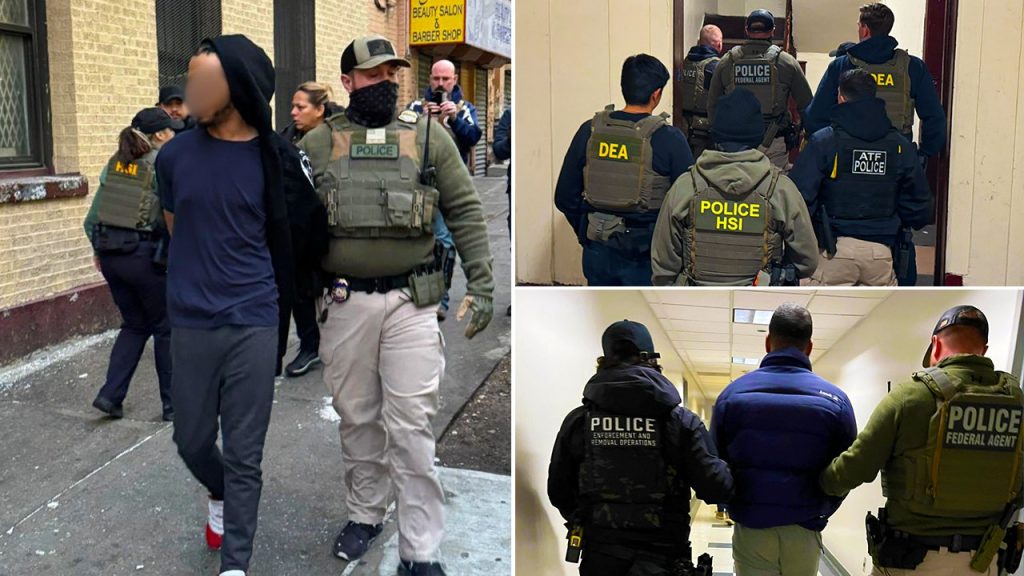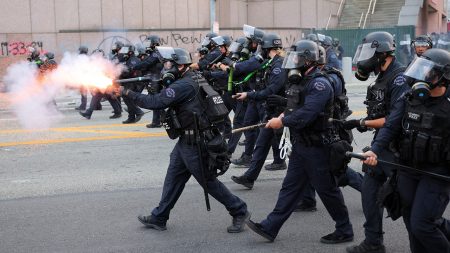The Immigration and Customs Enforcement agency (ICE) has significantly escalated its enforcement actions under the Trump administration, conducting a series of high-profile raids targeting individuals deemed to be in the country illegally. In a span of just nine days, over 7,400 arrests were made across multiple states, accompanied by an increase in deportations. This surge in activity reflects the administration’s hardline stance on immigration, with a stated focus on apprehending violent criminals and gang members. The administration has also floated the controversial proposal of utilizing the Guantánamo Bay detention facility to house a significant number of these individuals.
ICE’s operations have been characterized by coordinated efforts involving multiple federal agencies, including the DEA, ATF, and FBI. These raids have targeted various locations, including homes, workplaces, and other establishments. The agency has actively publicized its efforts, highlighting arrests involving individuals accused of serious crimes, such as sexual offenses against minors, rape, weapons charges, and drug trafficking. Particular emphasis has been placed on apprehending members of violent gangs, such as Tren de Aragua and MS-13, with prominent arrests being showcased to demonstrate the administration’s commitment to public safety.
High-ranking officials, including Border Czar Tom Homan and Homeland Security Secretary Kristi Noem, have underscored that the enforcement focus is directed at the “worst of the worst” offenders. Noem, who participated in a raid in New York City that resulted in the apprehension of an alleged gang leader, has emphasized the positive impact of these operations, asserting that they have made communities safer. While ICE has publicly detailed over 60 cases and the White House has highlighted at least 20 more, comprehensive criminal histories for the vast majority of those arrested have not yet been released, leading to some questions about the scope of the crackdown.
The Trump administration’s aggressive immigration policies extend beyond increased enforcement actions and deportations. President Trump has also directed the Pentagon to prepare the Guantánamo Bay detention camp to potentially house up to 30,000 “criminal illegal aliens,” a move that has sparked considerable controversy. Secretary of Defense Pete Hegseth confirmed this plan, stating that “all options are on the table” regarding military action against drug cartels, further solidifying the administration’s hardline approach. While initially described as an executive order, the directive was later clarified as a presidential memorandum.
Public reaction to the ICE raids has been divided. Some community members, particularly in areas experiencing high crime rates, have expressed support for the increased enforcement actions, welcoming the removal of individuals perceived as threats to public safety. Local activists have echoed these sentiments, stating that residents, both immigrant and citizen alike, desire safer streets and appreciate the focus on law and order. However, the raids have also faced criticism, particularly in sanctuary cities.
Mayors of major cities like Chicago and Boston have reaffirmed their commitment to maintaining their sanctuary city status, which limits cooperation with federal immigration authorities. This reflects a fundamental disagreement over immigration policy and enforcement priorities, with some arguing that the raids are overly aggressive, indiscriminately targeting individuals regardless of their criminal history, and undermining trust between law enforcement and immigrant communities. The conflicting perspectives highlight the ongoing national debate surrounding immigration enforcement and the balance between public safety and the rights of individuals.










